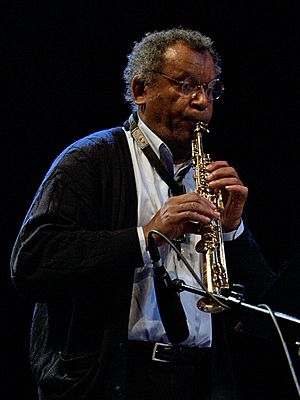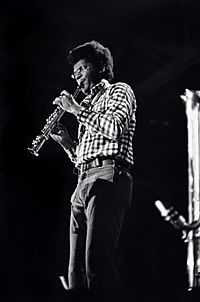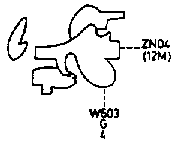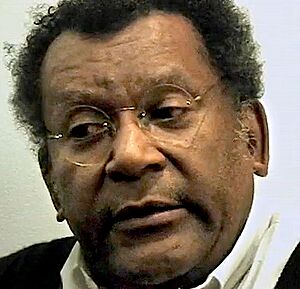Anthony Braxton facts for kids
Quick facts for kids
Anthony Braxton
|
|
|---|---|

Braxton in 2007
|
|
| Background information | |
| Born | June 4, 1945 Chicago, Illinois, U.S. |
| Genres | experimental music, contemporary classical music, avant-garde jazz, free jazz, free improvisation |
| Occupation(s) | Composer, musician, educator |
| Instruments | Saxophones, clarinets, flute, piano |
| Years active | 1968–present |
| Labels | Delmark, Arista, Hathut, Black Saint, Music & Arts, Antilles, Leo, CIMP |
| Associated acts | AACM, Creative Construction Company, Circle, Dave Holland, George E. Lewis, Kenny Wheeler, Marilyn Crispell, Mark Dresser, Gerry Hemingway |
Anthony Braxton (born June 4, 1945) is an American composer and musician famous for his work in experimental music and avant-garde jazz. He is a multi-instrumentalist, meaning he can play many instruments, but he is best known for playing different types of saxophones, especially the alto saxophone.
Braxton grew up on the South Side of Chicago and was an important early member of the Association for the Advancement of Creative Musicians (AACM). In 1969, he released a famous double album called For Alto. It was the first-ever full album of music for a solo saxophone, and it received great praise.
He is a very productive composer who has created a huge amount of music in many different styles. Braxton has won major awards, including a MacArthur Fellowship and an NEA Jazz Master award. He has released hundreds of recordings. Some of his famous projects include Creative Orchestra Music 1976, which won Album of the Year from DownBeat magazine in 1977.
Braxton doesn't like to separate composed music from improvised music, and he often blends them together. He also taught music at Wesleyan University for many years until he retired in 2013.
Contents
Early Life and Background
Braxton was born in Chicago, Illinois. His parents divorced when he was young, and he grew up with his mother, stepfather, and three brothers. He lived on the South Side of the city, which was a poorer area. As a kid, he delivered newspapers, sang in a church choir, and loved rock music.
Growing up, Braxton was aware of the unfair treatment and violence that Black people faced in his city. He heard about events like the Cicero race riot of 1951 and the death of Emmett Till, a teenager from Chicago. These experiences shaped his understanding of the world.
Education and Army Service
In high school, Braxton was very interested in technology and electronics. He took classes in drafting, where he learned to draw detailed plans called schematics. These skills later helped him create his unique musical compositions, which often look like diagrams.
After a semester of college, Braxton joined the United States Fifth Army Band in 1963. He was sent to South Korea, where he met other musicians who liked to improvise. He even started his own band there. After leaving the army, he returned to Chicago and studied philosophy and music at Roosevelt University.
Musical Career
The Beginning in Chicago
When Braxton returned to Chicago, he joined the Association for the Advancement of Creative Musicians (AACM). This group of musicians was dedicated to creating new and original music. On his first album, 3 Compositions of New Jazz (1968), he played over ten different instruments.
In 1969, Braxton recorded For Alto, a double album of music for only the alto saxophone. Before this, no one had ever released a full album of solo saxophone music. The album was a major achievement and inspired many other musicians to record their own solo albums.
Working with Other Musicians
In 1970, Braxton joined the band Circle with famous musicians like pianist Chick Corea and bassist Dave Holland. Throughout the 1970s, he led his own groups and recorded many albums, including Creative Orchestra Music 1976, which was inspired by jazz and marching band music.
In the 1980s and early 1990s, Braxton's main group was a quartet with Marilyn Crispell on piano, Mark Dresser on bass, and Gerry Hemingway on drums. In 1994, his incredible creativity was recognized with a MacArthur Fellowship, often called a "genius grant."
Later Career and Recordings
In the 1990s and 2000s, Braxton recorded many albums of jazz standards, which are well-known jazz songs. On these recordings, he often played the piano instead of the saxophone. He continued to be very productive, releasing large box sets of music. For example, in 2020, he released a 13-CD set of his quartet playing jazz standards.
Braxton is known for his huge and diverse collection of recordings. He has collaborated with many different artists, including the noise music group Wolf Eyes.
How Braxton Creates Music
Braxton has developed his own special systems for composing and performing music. He has even written books to explain his ideas.
Unique Titles
Instead of regular names, Braxton often gives his compositions titles that are diagrams, drawings, or a series of numbers and letters. At first, these titles were simple diagrams showing where musicians should stand on stage. Later, they became more complex and included drawings of objects like train cars.
Language Music
One of Braxton's earliest systems is called "Language Music." He created twelve "language types," which are different ways of playing music, such as focusing only on trills (fast back-and-forth notes) or long sounds. In a performance, he can use hand signals to tell the other musicians which language type to use, guiding their improvisation.
Ghost Trance Music
From 1995 to 2006, Braxton created a series of pieces called Ghost Trance Music. These compositions were inspired by the Ghost Dance rituals of Native Americans. The main part of a Ghost Trance Music piece is a long, continuous melody that is meant to be played by the whole group.
However, musicians are not stuck playing just that melody. The music contains special symbols—circles, triangles, and squares—that act as signals. These symbols tell a musician that they can switch to improvising, play a different piece of music, or even play a composition from anywhere in Braxton's huge collection of works. This system allows for endless variety in every performance.
Personal Life
Braxton's son, Tyondai Braxton, is also a well-known musician. He was a member of the American math rock band Battles.
Awards and Honors
Anthony Braxton has received many awards for his contributions to music.
- 1981: Guggenheim Fellowship
- 1994: MacArthur Fellowship
- 2013: Doris Duke Performing Artist Award
- 2014: NEA Jazz Master Award
- 2020: United States Artists Fellowship
He has also received honorary doctorates from the University of Liège in Belgium and the New England Conservatory in the United States.
Discography
See also
 In Spanish: Anthony Braxton para niños
In Spanish: Anthony Braxton para niños




